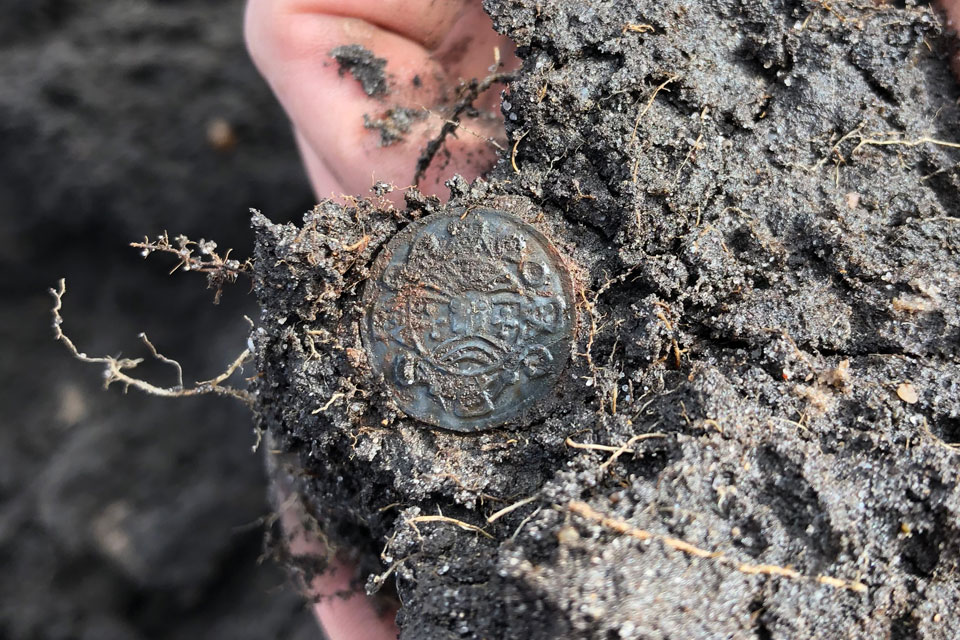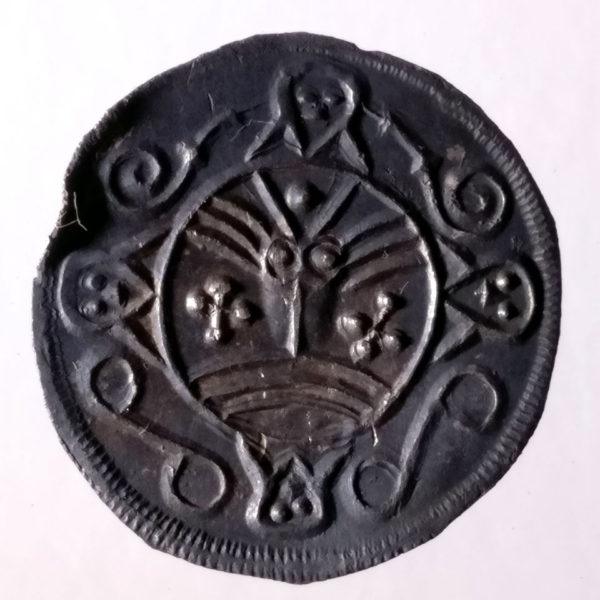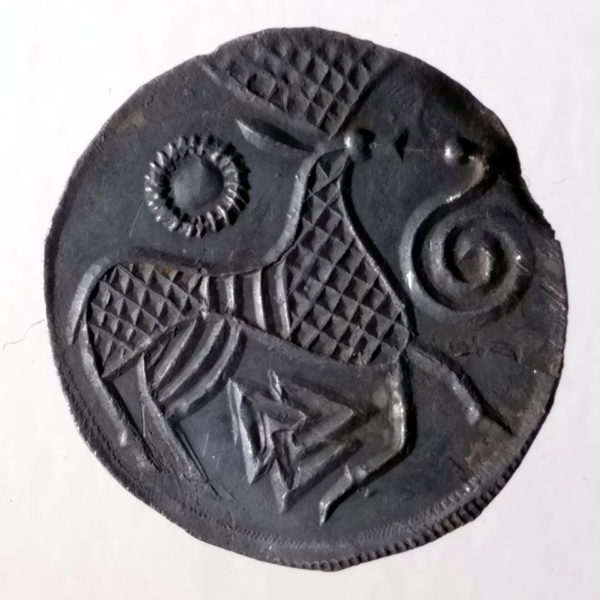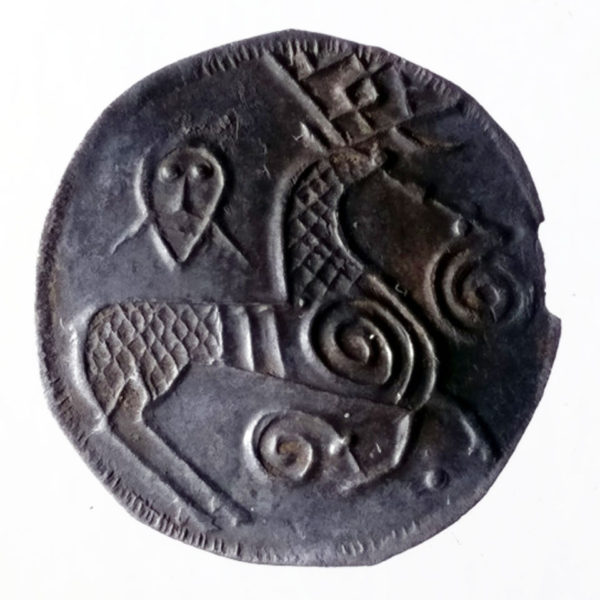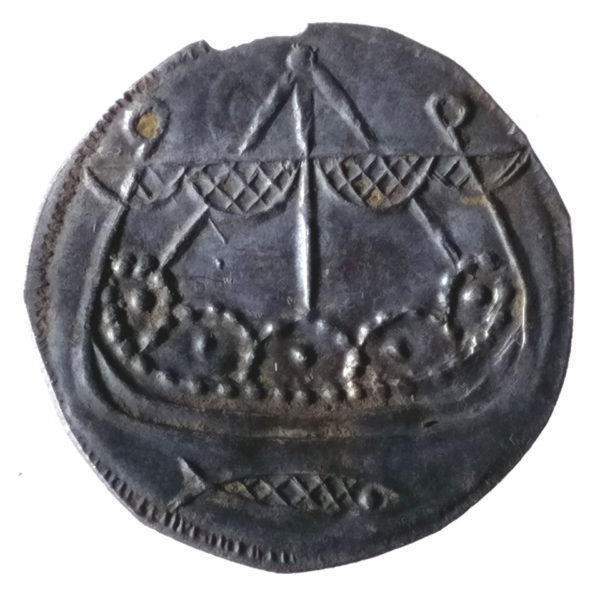Recently, a lucky punch from a detectorist resulted in the find of a very rare Viking coin. Soon, the find had multiplied to 252 coins, shedding new light on the rule of power in early Viking Denmark c. 800
Suddenly in August 2018, it was reported by an amateur detectorist that an extremely rare Viking Age coin had been found in a wet meadow not far from Ribe. The coin was a so-called ray-face/deer coin. On the obverse we find a crude face with staring eyes, bristling hair and a moustache. On the reverse, a deer or a stag, which kisses a snake? Or is the snake attacking the deer?
The newfound coin prompted the archaeologists to do a proper search of the meadow resulting in the discovery of a treasure trove of 252 coins in all. Of these, 249 presented a combination of the rare head/deer type, while the last three featured a beautiful rendition of a Viking ship with a fish swimming below the keel. The watery landscape had helped to preserve the coins, which seem pristine.
Technically the coins are categorised as belonging to the combination-group, KG 4. Accordingly, the coins have could be dated to c. 800-825. They were hidden in a bog or wetland at a time when Ribe was the most important emporium in Southern Jutland. At this time, Haithabu was still a relatively small settlement.
As of now, the Museum regards the find as a wetland-deposit intended as a sacrifice. However, already other explanations are proffered. Were the coins kept in a purse lost by a Viking merchant crossing the swampy bog? The pristine character of the coins indicate the collection of coins might have resulted from a
During the excavation, the location of the coins was mapped with precision GPS. The resultant map showed that the coins were spread over a large area, approximately 50 x 15 m and in the shape of an oblong. The spread of the coins suggests that they were not buried, but perhaps just kept in a purse, which was placed (or lost) on the ground. Afterwards, repeated ploughing would have spread the coins.
First of all, it must be noted that the coins appear pristine. They must have been used as coins and not just as hack silver. The coins had not been tested, but rather intended to be taken at their face value.
Secondly, they were surely minted in or near Ribe. Marine archaeologists have long recognised that the inspiration for the coins with ships derived from Dorestad pennies. However, the ships on the newly found coins are obviously “Viking Ships” and not the banana-shaped “Frisian Hulcs” known from the Dorestad coins. As yet, we don’t know how many dies can be identified, albeit it is clear from the published photos that several are present.
This treasure is a new and significant contribution to the history of the period c. 800 – 825, explains the archaeologist, Morten Søvsø, who is obviously exited about the new find. Not only does it complement the astounding results of the recent excavations in Ribe, currently being conserved and studied at Aarhus University. The cache of the 252 coins will probably shed new light on the political history of the early Danish kingdom of Godfred, he tells us.
Godfred
This king of the Danes was well-known to the Frankish chroniclers, who told about his exploits during the last stages of the Saxon wars as well as his repeated attacks on the frontier of the Carolingian Empire. Thus, in 808, Godfred was involved in attacks on the land of the Obodrites (present-day Vorpommern). This pillaging prompted the Franks to cross the Elbe to protect their border against, what the Royal Frankish Chronicle calls “the mad king”. In connection with these attacks, Godfred took a number of Slavic castles, as well as destroyed a trading place at the seashore called
“Reric, which because of the taxes it paid, was of great advantage to his [Godfred’s] kingdom. Transferring the merchants from Reric, he weighed anchor and came with his whole army to the harbour of Schleswig. There he remained for a few days and decided to fortify the border of his kingdom against Saxony with a rampart, so that a protective bulwark would stretch from the eastern bay, called Ostarsalt, as far as the Eastern Sea, along the entire north bank of the river Eider and broken by a single gate through which wagons and horsemen would be able to leave and enter. After dividing the work among the leaders of his troops, he returned home. “
From: Carolingian Chronicles. Translated by Bernhard Walter Scholz with Barbara Rogers. University of Michigan Press 1972, p. 88 ff.
Evidence of Godfred’s restoration of the so-called Daneverk has not been identified. The gate, however, was recently discovered and excavated, demonstrating that the entrance into the Danish kingdom was heavily fortified. Although Haithabu was probably founded earlier in the 8th century, its heyday as the Viking Emporium par excellence dates from after 808 – 10. We know that the newly found coins belong to the same period. Hence, it is more likely they were minted at Ribe, which had an essential role as a flourishing market centre already from c. 720 and onwards (this early date is indicated by the as yet unpublished results of the recent Ribe-excavations carried out in summer 2018).
Might we presume the newly found coins were minted at Ribe at the instigation of Godfred and as part of his endeavour to develop trade in Southern Denmark? Earlier excavations have shown that Ribe was indeed already a thriving market town with a money economy in the 8th century. Since the early 1970s more than 200 sceattas with their typical design featuring Wodan/Monster have been excavated at Ribe. More – as yet unpublished examples– have surfaced during the later years indicating that these coins were in use at least until the beginning of the 9th century. It seems likely that the idea of minting our new coins was fostered there; not least since the image of the ray-face on the new coins introduced c. 800 – 820 is akin to the “face” on some of the sceattas minted and found in Ribe from c. 725 and onwards. It seems logical to consider the newly found coins as representatives of those introduced after the scaettas were dropped c. 800 – 820.
However, even if the coins were part of a project to further integrate the Ribe economy in the network of powerful Viking Emporiums like Quentovic, Dorestad, and Haithabu – and thus minted in order to facilitate trade, commerce and royal customs – it is at least as likely that the coins also played a symbolic role in the fostering of the image of Godfred as a powerful king. As the litany has repeatedly claimed: “Kings strike coins, I strike coins, hence, I am a king”. What would be more natural for a burgeoning Danish king to utilise a central Carolingian symbol, coins, which he must have encountered not just as a partner in trading enterprises, but also as loot deriving from his continued skirmishes with Charlemagne and his sons? Especially, since he would also have been familiar with the minting and use of the sceattas in Ribe.
Christian or Pagan?
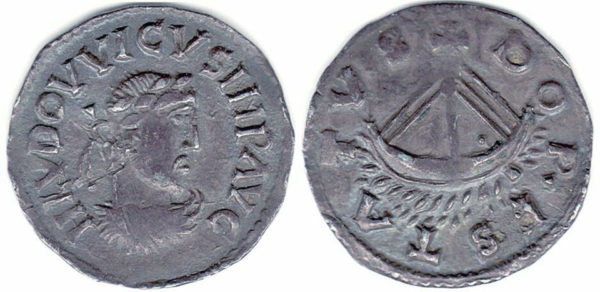
To understand the symbolic character of the new coins, however, it is necessary to consider them in their context.
Generally, it is believed that these Nordic coins were local derivatives of Carolingian coins minted in Dorestad. From 768 -790, these coins were fitted with the name of the king on the obverse, and with the place of the mint, Dorestad on the reverse. In 789 a new type was launched with +CARLVSREXFR circumscribing a cross, and with the site of the mint indicated on the reverse. However, late in his reign – after 800 – these coins were replaced with a new – more picturesqe – type, with the imperial bust of Charlemagne on the obverse, and a ship surrounded by the mint name, Dorestad, on the reverse. It is likely that such coins were part of the tribute, which Godfred received from the Frisians in 810. The cronicle informs us that it consisted of a hundred pounds of silver or the equivalent of 24.000 pennies.
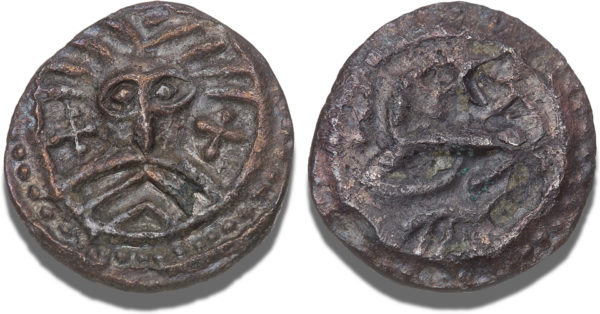
Might we imagine that either Godfred or his sons had this treasure reminted at Ribe and according to specifications? A closer study of the different types of the Nordic pictorial coins belonging to the so-called combination-groups 3 – 5 seems to indicate this might very well have been the case.
As can be seen from the newly found coins, the obverse is fitted out with a face. This face, however, seems to be an echo of the faces on the 8th century scaettas from Ribe (so-called series X) and not the profile of Charlemagne. The old epithet of Wodan/Odin should not be taken on face-value. This characterisation dates to 1860 and was originally voiced by a Frisian numismatist. In Italian, the coins are described as showing a “Testa di Legno”, head of wood, where the name “Wodan” has obviously been translated as “wood” (legna in Italian)! As these faces does not show two eyes, one of which is corrupted, we may limit ourselves to note that the portrait on the Carolingian coins differs radically from the one found on the Ribe-coins, which with its large and staring eyes decidedly reminds us of carvings on artefacts found in the Oseberg Ship grave from c. 834.

As said, the newly found coins show on the reverse ships sailing with fish below, as well as dears interacting with snakes. Other types of coins not found in the new assemblage, but belonging to the same combination groups (3 – 5), show images of Viking Halls, “redrawn” from Carolingian Temples depicted on coins from Charlemagne or his son, Louis the Pious. Other coins in the series show motives, which may be found on other scaettas from the beginning of the 8th century (the motives with a walking man or two roosters). Looking into the minor decoration on the coins, we should take into consideration that some of these iconographic details like the triskele can be found carved on the tent-stand found at Oseberg in Norway. Further, the four-legged deer, the coiled snake, and the ships remind us of paintings on the picture stones from Gotland. Clearly, the pictorial schemata are Nordic.
Especially evocative is the deer. The animal reminds us of Eikthyrnir, according to the legend a stag, which stands on the roof of Valhalla and eats from the leaves of the great tree, Yggdrasil. From it horns drip water, which feeds the rivers and seas of the earth, among them Hergelmir, in which the serpent or dragon, Níðhöggr and countless snakes lives, feeding off the roots of the tree. The story is told differently in the Poetic Edda, Grimnismal, and Gylfaginning, but the main elements set the same scene.
However, another possibility is of course that the symbolic repertoire is Christian, as indicated by coins combining the motive with the stylish Viking ship sailing on a sea filled with fish. In the same way, the stag and snake on the reverse might symbolically render Jesus taking on the devil. On the other hand, this is contradicted by a die, which is not present in the new assembly: a coin with a ship on the reverse, and two roosters on the obverse. Of course, a rooster features in Jerusalem in the story of Good Friday. But roosters (in the plural) are also present in the Norse mythology, where three of them crow out a warning about the impeding Ragnarök.
A univocal answer to this complicated question is not readily available. We know, however, from the recent excavations in Ribe in 2018, that a Christian community was present c. 800. Three newly found leaden amulets or pendants indicates this. The amulets in the form of crosses of St. Andrew were found in the workshop of a metalworker together with the moulds, suggesting that the local market for such trinkets was not insignificant.
Might the newly found coins bear witness to a syncretistic approach to the question of religion? Do the coins signal that a “rewriting” of the Nordic myths inspired by Christianity took place already at this time? Godfred and his Vikings would have been well-informed about the role, Christianity and the Christian church played in the Saxon wars south of the border. From 777 to 782, Widukind, the pagan leader of the Saxon faction, found shelter up north beyond the Danish border, perhaps at the court of Godfred’s predecessor. Later we hear of negotiations between representatives of Charlemagne and Godfred concerning refugees from the Saxon wars, who Charlemagne wishes to lay his hands on. On the other hand, the design of the coins are without doubt inspired by the Scandinavian artform named after Oseberg. As are the motives, which have deep roots and a significant resonance in the ensemble of stock motives in the Scandinavian world c. 800.
As always, new archaeological finds provide not only answers, but also numereous new questions. Hopefully, in the future the new find will encourage not just numismatists and archaeologists, but also art historians to fully explore the cultural and historical ramifications of the 252 coins.
SOURCES:
En skat af Ribe-mønter fra vikingetiden ofret til mosens guder
By Morten Søvsø
Sydvestjyske Museer. Oktober 2018
(Press Release)
The Hedeby Coinage
By Björn Varenius
In: Current Swedish Archaeology 1994, vol 2 p. 185 – 194.
Series X and Coin Circulation in Ribe. By Claus Feveile.
In: Studies in Early medieval Coinage. Vol 1: Two Decades of Discovery. Boydell 2008, pp. 53 – 68
Dorestad in the ninth Century: The Numismatic Evidence
By Dr. Simon Coupland
reprinted in: Carolingian coinage and the Vikings: studies on Power and trade in the 9thcentury, Ashgate 2007, pp. 5 – 26
Before They Were Vikings: Scandinavia and the Franks up to the death of Louis the Pious
By Daniel Melleno
A dissertation submitted in partial satisfaction of the requirements for the degree of Doctor of Philosophy in History in the Graduate Division of the University of California 2014
A Striding Man from Tissø – a rare imitation of Charlemagne’s Dorestad Coinage
By Anne Pedersen
In: Numismatisk Årsskrift 1994-96, pp. 22-40
Skeppsmyntet från Okholm. Om danska 800-talsmynt med fisksymboler
By Brita Malmer
In: NNUM 2000, Vol 5, pp. 103-109
